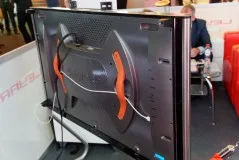German STB maker, ABox42, was showing a new middleware solution that it has developed that is called ABox42 OPA (Operator Android). The middleware allows for the development of Android boxes with security for pay TV operators. The secure STB environment can be secured from an open Android implementation, allowing users to switch between the “sand boxes”. The company is already in mass production of its M40 HEVC UltraHD STB which is based on the Broadcom BCM7251S and can support HEVC at 3840 x 2160 with 60fps. It can support HEVC over IP as well as traditional broadcast. The user interface is built on HTML5.
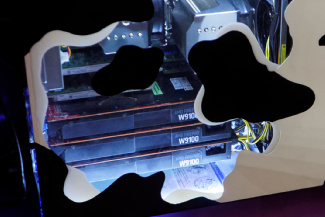 3 AMD GPUs brings plenty of power!AMD was showing how its GPUs could be used, via the OpenCL API to accelerate video software. Nuke was running on Apple Macs, with dual GPUs and there was a real power system with three W9100 boards being used by The Pixel Farm software to build 3D models directly from captured video – almost in real time. The technology is used by studios for fixing issues when content has been filmed, but later needs changing. If you have a lot of footage of a building, you can quickly build a realistic looking 3D model from the 2D photography. Impressive.
3 AMD GPUs brings plenty of power!AMD was showing how its GPUs could be used, via the OpenCL API to accelerate video software. Nuke was running on Apple Macs, with dual GPUs and there was a real power system with three W9100 boards being used by The Pixel Farm software to build 3D models directly from captured video – almost in real time. The technology is used by studios for fixing issues when content has been filmed, but later needs changing. If you have a lot of footage of a building, you can quickly build a realistic looking 3D model from the 2D photography. Impressive.
AMD also showed software from Ventuz that can be used for video walls and LED displays and now runs on the GPU. We heard that, at one football stadium, a very slow content preparation process was replaced with a very fast system, which was a shock for users. DaVinci software was being used on the AMD booth to demonstrate real time colour grading using dual GPUs, and AMD told us that Avid is now supporting OpenCL.
Aoto was demonstrating its 2.8mm pitch LEDs in a convex configuration with 1,200 cd/m² of brightness. The company also had a demo of its 1.7mm pitch LEDs which have 1,200 cd/m² of brightness, more than most sub-2mm LEDs and Aoto told us that this is because it has better current control than some of its competitors. We were surprised to see the company running UltraHD content marked with an AUO logo!
 AOTO was using AUO content to show its LEDs
AOTO was using AUO content to show its LEDs
Nexguard (a Civolution company) and Ateme said that they will launch a joint solution for the forensic watermarking of pre-release High Dynamic Range (HDR) video content. The solution is based on NexGuard Software Development Kit (SDK), integrated with Ateme Titan Software Transcoders.
Barco Silex was at the show to demonstrate and promote its SMPTE ST-2042 lightweight compression technology which is based on the Dirac codec that was developed by the BBC and is also known as VC2-LD (low delay). The codec is an intra codec based on wavelets and is capable of high quality, making it suitable for contribution and production. It can also be used for KVMs as it typically has just a four line delay with no external memory. The design can be implemented in FPGAs or ASICs. The codec is open and there are no licensing costs or issues.
Broadcom announced the BCM72415/BCM74285 (IP/Cable) and BCM74295/BCM74305 (cable only) which are new SoCs for mid-range cable and ip STBs and which can all support 10 bit 1920 x 1080 60P HEVC content, saving bandwidth. The first two models have VC4 OpenGL 3D processors and CA/DRM features. The cable models have an integrated 400 Mbps MoCA® 2.0 IP Coax modem.
Canon showed its 24″ “on-site” monitor, which was launched at NAB and is due to start shipping in November. The monitor is designed to be durable and runs 4096 x 2160. The backlight is direct and the company told us that coverage is around 80% of Rec. 2020. We asked the company if it had looked at QD technologies, but in a classically conservative Japanese way, we heard that the company is not quite convinced about QDs, yet. (Check out our report from the Canon New York event this week for more – (Canon Showcases HDR Monitors))
Christie was showing its 1.5mm LED technology at IBC for the first time. It has five LED pitches from 1.5mm to 4mm. The company is aiming at the fixed display market rather than the rental market. Christie’s 6P laser projectors were used in the IBC “Big Screen Experience” and showed very impressive colour performance, especially with the Inside Out content which is optimised for wide gamut.
A completely new screen is the FHQ981-T, a 98″ UltraHD monitor with an infrared curtain touch sensor system that was shown at Infocomm.
We bumped into Simon Parnall, now of Cisco, who showed us the NDS “project Fresco” TV video wall at IBC several years ago. He pointed out that while linear TV will probably survive in terms of providing curated content, he could imagine that watching a channel in a different sequence might be very popular in the future – allowing some programmes to be watched ahead of time, as well as behind time. He pointed out that the job of a network scheduler has not changed for many years, but it probably should.
Disney was in the future technology zone and was showing the tone-mapping technology that it has developed for use in content post-production. There were some very impressive demonstration images that showed how the company could take very high dynamic range content and compress the range, without losing detail and without losing quality. Importantly, the company has a way of splitting the edges and details from the overall brightness. The technology can also give some impactful “dream” type of effects. Check Disney Preserves (Some) HDR for Consumer TV for more details.
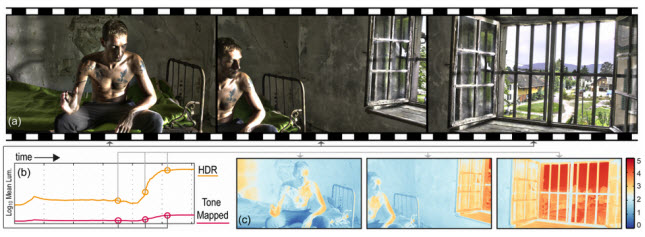 Disney’s tone mapping reduces the range of brightnesses to fit into existing delivery systems, but is very high quality and temporally consistent.
Disney’s tone mapping reduces the range of brightnesses to fit into existing delivery systems, but is very high quality and temporally consistent.
The EBU was showing various demonstrations and we looked at the BBC/NHK hybrid log demo, which the EBU is positive about, and also at a demonstration of high frame rates – material shot at 50Hz and 100Hz. The EBU is looking at different shutter angles and also the impact on viewers and is working with the 4Ever project. The group pointed out that, although 4Ever had said at the IHS event last week in IFA, that the viewer impact of 100Hz was smallish if you compared 100Hz native content with 50Hz material interpolated by the panel using MEMC, it was fairer if you compare 50Hz interpolated with 100Hz interpolated. In this case on a scale of 100, viewers see around 15 points of difference (compared to 10 for UltraHD resolution and 20 for HDR).
The EBU was also showing the NHK/BBC hybrid log gamma proposal for HDR standardisation with HDR content being shown directly displayed at the same time on an SDR display, without any support for the standard, as well as an HDR monitor, where, of course, it looked better. The point was to show that the same stream can be sent to existing devices without a problem. The EBU is very concerned about systems that need dual layers – it simply doesn’t believe these are feasible in live broadcast productions
Envivio is a codec and compression specialist which has tended to focus mainly on IP, but is now to be acquired by Ericsson. We talked to the firm about HDR and we heard that the company is closely following standardisation and has looked at Technicolor, BBC/NHK, and Dolby. It worked with Sky Deutschland on the HDR test as well as 4Ever in its tests. It has especially been developing realtime encoding and said that its HEVC encoding is getting down to 12Mbit or so for UltraHD. The company pointed out to us that cameras really need to be carefully aligned when you move to HDR – it’s a lot easier to make a mess of HDR than SDR.
Eyevis of Germany told us that its new cube with very narrow bezels is now available in 70″. It is also doing well, it says with LCDs at 58″, 65″, 84″ 85″ and 98″ in UltraHD formats. Eyevis was one of the first to modify LCDs to match the colour temperature of TV studios, but has no far seen any market impact from the sample LCDs shown by Samsung at Infocomm with this feature.
Hispasat was demonstrating Dolby Vision content and an UltraHD channel running at just 15Mbits – below the level that Sky used when it started transmitting FullHD with MPEG2, but now it’s UltraHD with HEVC. Hispasat was also demonstrating SAT>IP and had a flat antenna with SAT>IP integrated.
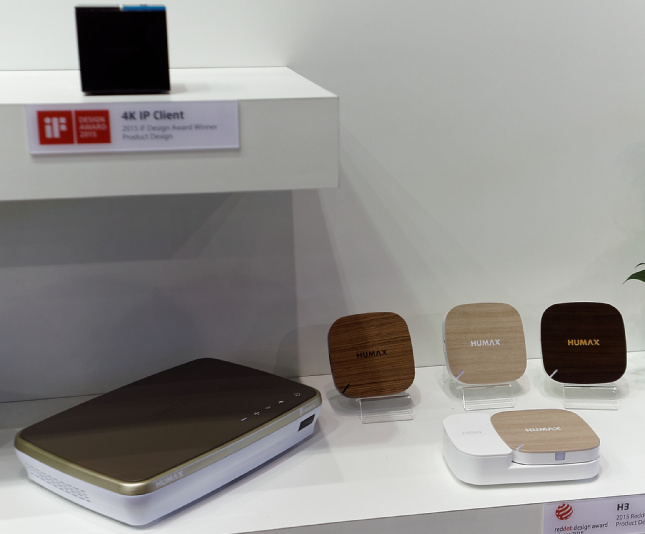 Humax has new industrial designs and a small ip clientHumax has both a retail business and an OEM STB division. The company started by showing us its latest products which have a new range of industrial designs, intended to offer more variety to users and get away from the conservative designs that the company has used in the past. It was also showing its latest four tuner boxes which allow viewing on any internet device within the network. It has small IP clients that can stream content around the home. The company has also got integrated CA and DRM to allow access to internet portals and has support for Maxdome and music streaming service Juke! It can also support Netflix in the UK. Humax was showing a mock up of a “wrapper” box that can be used with its boxes to expand them to add, for example, HDDs. The firm is open to ideas for expansion of the functions of the box.
Humax has new industrial designs and a small ip clientHumax has both a retail business and an OEM STB division. The company started by showing us its latest products which have a new range of industrial designs, intended to offer more variety to users and get away from the conservative designs that the company has used in the past. It was also showing its latest four tuner boxes which allow viewing on any internet device within the network. It has small IP clients that can stream content around the home. The company has also got integrated CA and DRM to allow access to internet portals and has support for Maxdome and music streaming service Juke! It can also support Netflix in the UK. Humax was showing a mock up of a “wrapper” box that can be used with its boxes to expand them to add, for example, HDDs. The firm is open to ideas for expansion of the functions of the box.
Ikegami was showing its prototype HDLM-3210 which is an UltraHD monitor. The company said that it expects to have a final camera with HDR support as well as a monitor by NAB. The firm also had a prototype 8K camera.
JVC had a stand, but the only display news was a new 24″ 1920 x 1200 (16:10) prototype broadcast monitor with broadcast features such as vectorscopes and other views. The company had few details on the new model, but told us that it would refresh the whole professional monitor line in 2016. The 24″ was using a new 10 bit IPS panel, but on the existing chassis. The company will also develop a 27″ 4K monitor with DisplayPort and HDMI, but no SDI.
Kaon Media was showing its latest UltraHD home gateways, which are now shipping. The firm confirmed that it has interest in its Android-based boxes (which are a speciality), mainly from the East, West and North of Europe. Operators see Android boxes as a good way to give access to a lot of content to its subscribers. The OS will also be useful for developing into the IoT.
Leyard had the 1.25mm 8K display that it had shown at Infocomm, which is 9600mm x 2700mm. It also had a sample at 0.9mm pitch and with 800 cd/m² that is expected to get into mass production by the end of 2015.
There was a 1200 x 675 resolution design that was built as a single display cabinet and is seen as being useful in studios. Broadcast is a key market for Leyard which has supplied ABC, ESPN, RTL etc. The company told us that it thought that 800 cd/m² is plenty of brightness for broadcast – many studios run at lower brightness. It’s contrast that’s important. Leyard spoke to us about building “monolithic” LED TVs at ISE and the company sees this as a key long term goal. (Leyard Pushing Small Pitch LED)
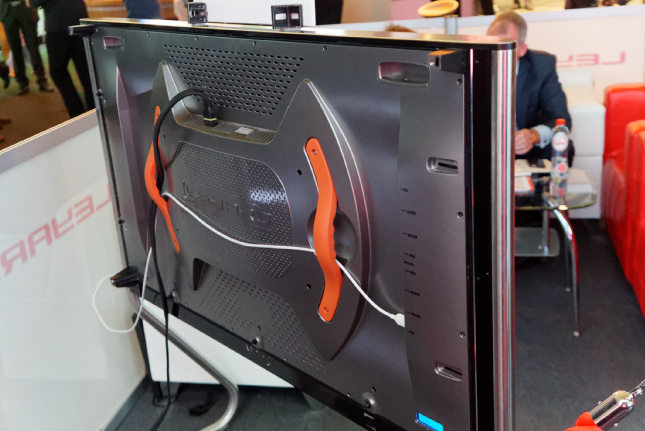 Leyard showed this single LED module and is aiming to start competing with LCDs for TV
Leyard showed this single LED module and is aiming to start competing with LCDs for TV
Lilliput is a Chinese maker of small monitors, since 1993, including field monitors and makes a wide range up to 28″ with UltraHD and, apparently, an IPS panel at that size. It also makes industrial PCs.
Matrox had its video group at the event, but not the graphics group. We looked at the Monarch HDX system which is used for real time H.264 encoding. The HDX has two encoders, allowing separate stream and record processes at the same time. There are SDI and HDMI inputs and there is also an HDMI only version. The company highlighted the integrated scaling, de-interlacing and noise reduction processes in the system.
MaxLinear got together with STMicroelectronics got together to make a reference design using its Full-Spectrum Capture (FSC) satellite receivers with ST’s STiH418 4Kp60 Ultra High Definition (UHD) decoder. These are combined with Quantenna’s QSR1000 4×4 802.11ac “Wave 2” WiFi chipset. For mid-range UHD personal video recorder (PVR) applications, the platform can be configured with four satellite TV tuners, UHD TV and picture-in-picture (PiP) display, plus transcoding and WiFi streaming of two HD channels to WiFi-enabled client devices. OEMs can also use the reference design as a high-end satellite home media server with advanced services including eight satellite TV tuners, UHD TV and PiP display, transcoding and WiFi streaming of four HD channels to WiFi-enabled client devices, up to eight simultaneous HDD recordings, and fast channel change on multiple TVs.
Maxlinear also said that ZapperBox, a developer of compact STB-stick solutions is using the MxL603 cable tuner and Kore-3 EN7120 SoC to create an HDMI dongle that provides a simple connection to the TV and an F-connector that enables a direct link from the wall to the stick. We’re used to HDMI sticks for OTT content and DVB-T, but not so much for cable TV.

We haven’t made this award for a while, but we feel that MStar deserves a special prize for its extreme unfriendliness to and rude treatment of the press. We won’t go into the details, but really the firm needs to get its act together if it wants to keep growing. It’s parent company, Mediatek, seems to have come to understand the importance of marketing over the last year or two, as we have commented.
Nagra announced a complete Netflix application STB reference solution as part of its OpenTV 5 connectware which will deliver popular pay-TV and SVOD content, both accessible from a common user interface and a single TV input. In addition, Netflix is adopting Nagra PRM as a Netflix-supported DRM. Nagra also said that MStar would include Nagra-On-Chip-Security (NOCS) for TV and the Nagra anyCast Connect security client in MStar 4K UHD TV SoCs which will allow access to pre-integrated Nagra CAS and DRM features on connected TVs from this year, with TV sets due in the market next year.
The NEC broadcast system division was showing a new ultra-low latency real time compressor and decompressor. Typical latency times for HEVC encoding are from 20ms – 300ms (there’s a trade off – lower latency means less efficient compression). That compares to standard products which typically take from 600ms to 1500ms. There are FullHD and UltraHD versions of the boxes.
Neulion, which now owns codec developer, Main Concept, and delivery system company, DivX, and was at the show to highlight that its UltraHD DivX software is now supported by Broadcom and MStar. The firm told us that with HEVC, it has now got bitrates down to 15Mbps for UltraHD content at 50fps. It was also showing live encoding performed on a dual Xeon PC (note that Lenovo now has a notebook with a single Xeon [Lenovo Boosts Mobile Workstations]). The company said that Intel’s new Skylake chips have boosted video performance and can be used at the low end of the market. The firm said that HEVC is around 35% compressed, compared to H.264. 50% reduction may eventually be possible as encoders are optimised, but that will tend to be material dependent.
NHK had a demonstration of its joint proposal for a hybrid log gamma technology that it has developed with the BBC to demonstrate 8K UHD with HDR at the event. The comparison with the 8K SDR was clear. All 8K will be HDR. There was also a demonstration of the 8K 13.3″ Sharp OLED that was shown at SID a couple of years ago, but it looked better to us, although it’s a long time since we saw it.
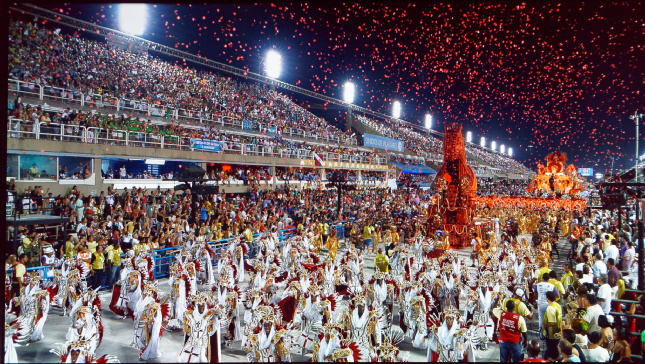 The image quality on the 13.3″ 8K OLED was great
The image quality on the 13.3″ 8K OLED was great
Panasonic had lots of new cameras on its big booth, but nothing new, we were told, in monitors.
Silicon Core was on the Mode-Al Frame booth and was showing the 1.2mm LED technology that it has shown before (we reported on it at infocomm) and it was being shown in a 3840 x 1080 format. The company has sold its first displays at this pitch and because it is running at lower brightness, lifetime is quoted at 150,000 hours. It will appear in a museum. The company is working on sub- 1mm pitch and we might get to see this at ISE. The key to achieving this is to bond the LED chips directly to PCBs. The company is looking also at applications in control rooms and board rooms as well as broadcast.
![]() Silicon Core showed its 1.2mm LED
Silicon Core showed its 1.2mm LED
Sony was showing its latest OLED and LCD broadcast monitors, including the DCI 4K BVM-X300 which supports HDR via the ST 2084 PQ profile. It, of course, looks great and supports a peak brightness of 1,000 cd/m², but is not new. We asked about the coverage of Rec 2020 and we heard that its ‘around 85%”, although it supports data mapped to that colour space.
SpectraCal is a US company that was making its first appearance at IBC. The company’s mission is to make display calibration “quick and simple”, where it is often slow and complicated. One of the key outputs (other than a much better looking display) is a report of the calibration and the firm told us that NetFlix is insisting that content is submitted along with a report in the same format as the SpectraCal version, to show that the final grading/testing display is correct. The company has clients globally (including Dolby and Technicolor) and can calibrate displays for Dolby Vision grading. It can also calibrate RGB OLEDs or WOLEDs. Colorimeters are getting better, which is helping the use of calibration and can cope more easily with multiple display technologies and this can usually be done with software updates. As well as grading and production monitors, Spectracal is finding good demand for video wall and multi-display calibration.
Spectral Edge was in the STMicroelectronics innovations area. The company is a small spin-off from the University of East Anglia and based on work led by Prof. Graham D Finlayson on colour vision. Spectral Edge, which has eight people, has developed software that can run in ST’s STB SoCs (the Cannes series which have dual ARM A9s and Mali GPUs) that can, to some extent, correct an image shown on a TV to look better for a person with colour blindness. The company has undertaken consumer research to suggest that users might be prepared to spend $8 per month or $70 per year for the service. The firm has a licensing model based on flat fees based on operator size. (Our reporter is colour blind and saw some difference between the standard display and the “corrected” version. Greens, especially, looked different).
Spin Digital is a codec developer and was showing its latest HEVC 8K implementation. The firm has had trouble getting hold of good 8K content (it is in talks with NHK) but was showing 8K P60 in 4:4:4 10 bit format being compressed on a dual Xeon-based PC (using, apparently, 12 cores). The bit rate is 80-100 Mbit, which is in line with NHK’s expectation. To get over the lack of content, the firm had stitched together 16 FullHD videos!
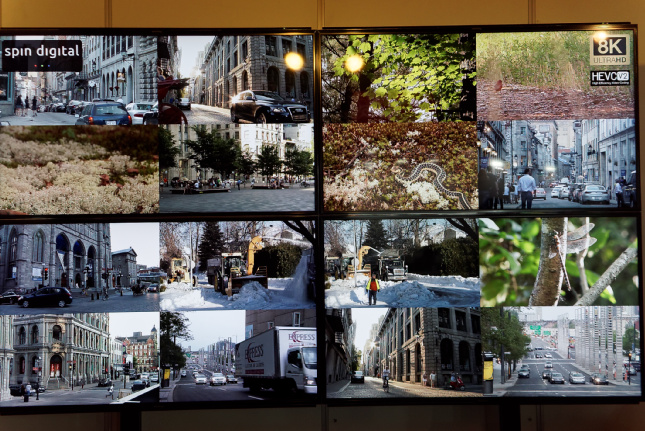 Spin Digital made an 8K demo using 16 different FullHD sources
Spin Digital made an 8K demo using 16 different FullHD sources
Teleste of Finland said that it has developed a new technology called LTvE that supports both DVB-T and LTE which is captured by a directional outdoor antenna and transmitted to an in-house network via the existing coaxial cabling and wall outlets. The availability of the LTE signal is also strengthened throughout the house via a small indoor antenna. In addition, high-quality TV broadcast is quaranteed through reduced LTE interference.
Thinklogical, that we reported on during the Displa y Summit at Infocomm, was attending IBC for the first time and told us that it is seeing a really good response to its fibre-based KVMs which are uncompressed. The company can support DCI 4K in 4:4:4 with two optical fibres. For WCG/HDR content with higher bit depths, the firm can go up to three fibres. We asked about the light compression systems such as Lici and Tico, but Thinklogical told us that it had heard of issues with latency in compressed systems, so prefers to stay uncompressed. The firm can develop copper/optical hybrids and will show that at ISE.
Unilumin had an impressive 3 x Full HD (5940 x 1080) resolution display built with its 1.2mm 800 cd/m² LEDs. It is already in mass production and has already been deployed in the US in broadcasting. The company had also put a small display using its 0.9mm LEDs near the Christie booth.
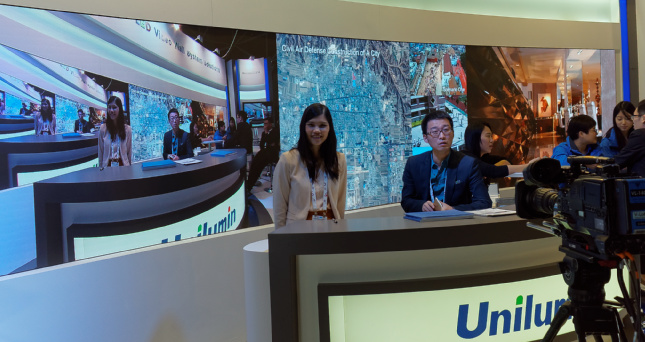
Security company Verimatrix said that MStar would integrate the Verimatrix VideoMark security into its SoCs. As a result of the collaboration, MStar’s STBs now meet the redefined security requirements for UHD/4K video services as described in the MovieLabs Specification for Enhanced Content Protection.
Vixs was a pioneer of UltraHD and we have reported before on the company’s UltraHD “Golden Reference Design” Mk 2, which was being used by, essentially, all the major codec suppliers at the event as well as many other companies as a reference source. Although Vixs is not really a system supplier – it’s main business is chips – it has used the box as a way of promoting itself and opening discussions with companies. We had a long chat with the firm about the different HDR technologies – it was an early company to support Dolby Vision, but is also working on supporting the Philips scheme, which has advantages.
Vixs told use that a number of companies are looking at ways of storing UltraHD/HDR content on viewer’s hard disks, so that they can be “trickle streamed” to hard disks when the network is not busy. However, the studios were concerned about this, so a standard, SCSA has been developed to secure the contents of disks. Vixs told us that it is the only supplier of chips for this application.
STB maker, XGem is working with NetRange to integrate the Netrange SmartTV portal and OTT ecosystem. (We were surprised that NetRange did not seem to be at the show – Man. Ed.).

